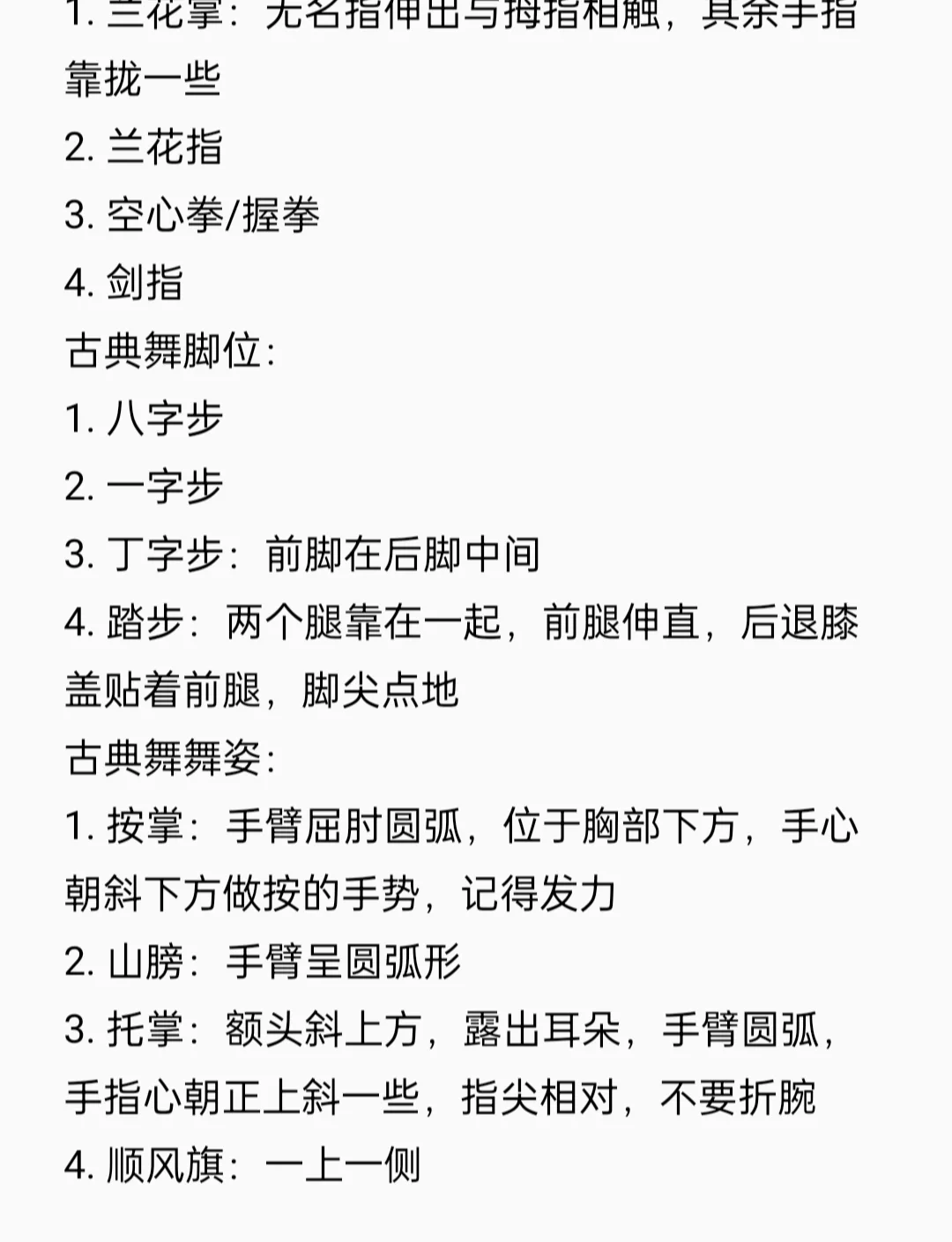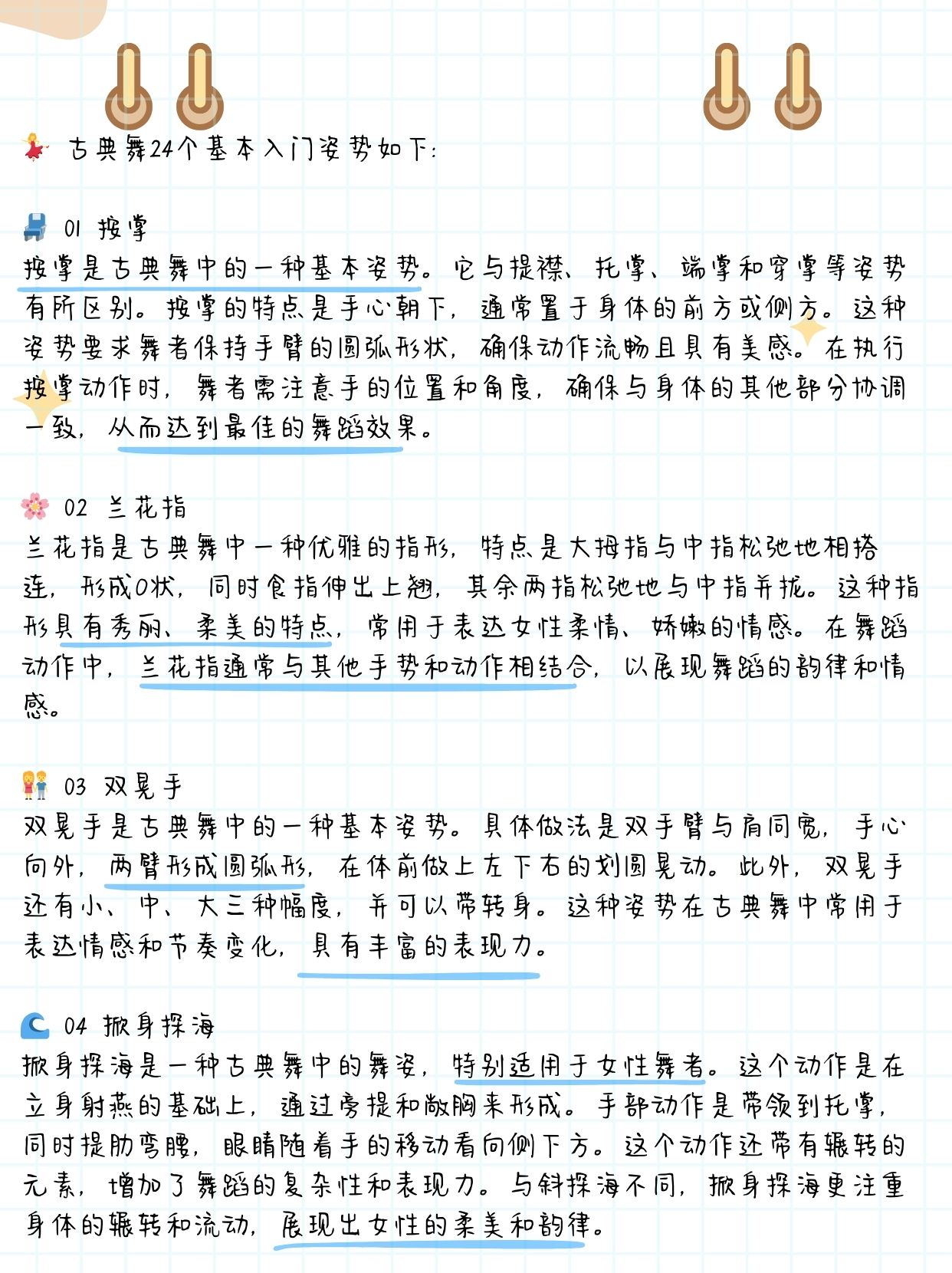3. Put your shoulders on your legsClassical Dance Basic Skills Training CourseForm a straight line with the crotch, with the toes tight, and cannot leave the ground. 4 Kneel with your legs vertically, retract your right leg first, keep your knees straight, then retract your legs to the left, then get up and kneel with your legs. 5 Support your hands on the ground, align your fingertips with your shoulders, clip your arms between your ears, hold your back on both sides of your ears, hold your back feet still, and slide your hands forward slightly. Basic skills of classical danceClassical Dance Basic Skills Training CourseThe training method emphasizes continuous practice every day, just like sawing a rope and breaking a tree.
The basic training of classical dance mainly includes the following contents: Kicking exercises, kicking the front legs, keeping the front legs perpendicular to the ground at 90 degrees, while keeping the lower legs from the ground. The toes are straight. Kicking the other legs are straight. Lie on your side. The toes are straight. Kicking the legs at 90 degrees with the ground. Use your shoulders to close the legs tightly to ensure that the legs are in a straight line with the crotch, the toes are straight, and the legs cannot be separated from the ground. Train your legs to kneel vertically, retract the right leg first, and the knees cannot be bent, and then fold your legs.
Prepare to sit and exert force from the ankle joint, pass through the hooking toes and soles, and concentrate the strength at the ankle joint. In the training form, the hooking of the feet can have straight and open feet. The decomposition exercise method of hooking the feet can be treated as doing the hooking of the toes first and then doing the complete hooking of the feet. 2 Pressing the front legs and pressing the front legs is based on sitting posture, with the legs stretched straight and flat. In the hooking and stretched shape, the legs are combined with flat reaching out and holding the palms.
The first step for adults to learn classical dance is to press the legs. This process may cause pain, but it is this feeling of pain that helps us gradually soften the body. Next, kicking, horizontal and vertical movements. These basic skills can not only enhance the flexibility of the body, but also lay a solid foundation for subsequent learning. Classical dance not only emphasizes basic skills, but also attaches great importance to technical training. Rotation and jumping are indispensable parts of it.
Practice for one squat with legs 1 small eight-foot step half squat full squat 2 large eight-foot step half squat full squat 3 step half squat full squat 4 lunge step squat front side 5 moving palm-diving step men's single leg squat 1 end leg squat 2 tuck leg squat 3 cross leg squat 4 loop tuck leg squat side leg loop move back to form a leg lift and then tuck squat squat 2 waist practice waist is the axis of body movement and dance movements, and the waist movement.
Before starting to learn classical dance, students first need to practice leg pressing, which is the starting point of basic skills training. Then, they will practice movements such as kicking, horizontal forks, vertical forks, and waist, which are all basic training. With the improvement of skills, students will gradually be exposed to more technical movements, including a wide variety of rotation movements such as rotation and jumping, such as upright rotation, dance, and compound rotation, which are all part of the rotation skills.
To learn classical dance, you must first practice your basic skills solidly. You can practice through the following basic movements: 1 Kick the front leg and kick the leg at 90 degrees perpendicular to the ground. The lower leg cannot leave the ground. The toes are straight. 2 Kick the side leg and lie on the side. The toes are straight. Straight, kick the leg at 90 degrees to the ground. 3. Use the shoulders to stick the leg. The legs and crotch are in a straight line. You cannot leave the ground. Keep the toes straight. 4. Turn the legs vertically. Kick the legs and retract the right leg first. The knees cannot bend.
Therefore, whether in the basic training of China classical dance, the waist training is emphasized in the training of the basic courses with the waist as the axis, or the training of the waist in the requirements of the body courses, the waist control force of the movements is basically moderate to the strong point step turning. The waist training in the basic training course emphasizes the training of students 'waist abilities and emphasizes the creation of training.
There are two basic ways to press the side leg. 1. The legs form the suction leg and the side leg respectively. The hand position is to hold the palm and the hand position is to press the side leg. 2. Press the side leg in a horizontal fork posture to prepare to take the left leg as an example. The right leg is to stand upright on the back, the left leg is extended sideways and far, and the hands are to hold the palm and press the palm. In the prepared posture, use the palm and hand to lead, and drive the body to close the leg with the straight knee to the basic training skills of classical dance are basic.
Ground training for a dance is a form of space-occupying dance training. China classical dance basic skills training includes ground training in form. The content of ground training for the basic skills of China classical dance can mainly be summarized as flexibility training, commonly known as soft opening training, strength training is also called ability training. The three aspects of technical skills, movement training, flexibility, strength and technical skills are the three main technical components of a dancer's career. It is also a must for a professional dancer.
The Longwu Dance Zero Basic Training School in Shenglong Square, Weiyang District, the northern suburbs of Xi'an, tells you what the basic skills of classical dance are. This is the most basic training content in basic dance training. The exercises of pressing the front and rear legs can help open the ligaments of students' leg joints. When pressing the legs, pay attention to the upright leg joints, open the instep outward and straight, and keep the upper body upright and pressed downward. There is no gap between the upper body and the legs.
Basic training in classical dance requires squatting practice ldquo squatting rdquo is the training of flexion, extension and bending of the legs. Through squatting practice, the joint ligaments and muscles of the legs are flexible and elastic. This is an indispensable condition for male and female dancers to master skills. Not only must jumping be elastic, but almost all skills are inseparable from squatting movements. At the same time ldquo squatting rdquo also has the effect of enhancing the strength of the back and squatting with both legs in a small eight-step.
Waist swing is to practice waist softness and control strength. There are many methods. When you start practicing waist swing, you can practice on the handle pole, sit on the handle pole, and throw with the support of your feet. You can see the frequency of this video screen TPwgBAGl 5tw depends on your own conditions, but the waist swing must be done in one go. When you go down and get up, you can form a complete waist swing.
Among them, the arms need to maintain a slight reverse force with the turning direction to prevent the body from losing its center of gravity, and effectively control the speed, while the axis of the head plays a role in stabilizing turning, maintaining the inclination of the body, and increasing the aesthetic feeling of turning. 2 The key points to master the middle part of the body The middle part of the body refers to the waist and hip part of the human body. This part is the main source of turning power in classical dance and the main axis of the turning movement. During practice, the waist and hip needs to be used.
This requires dancers not only to have solid basic skills and technical skills, but also to have important means of expression under the specific artistic norms and aesthetic characteristics of China's classical dance. The body charm enables classical dance to break through the limitations of traditional opera routines and movements,"change its shape and promote its spirit," grasp the core aesthetic characteristics of classical dance from an aesthetic perspective, achieve a unique combination of "spirit" and "shape", and play an important role in classical dance teaching and training.
The position is slightly lower than the shoulders. It is the result of the combination of step position, hand position and hand shape in the basic skills teaching materials of China Classical Dance. It is the result of the combination of step position, hand position and hand shape. It constitutes the basic posture in the basic skills teaching materials of China Classical Dance.
Teaching the basics of classical dance. Classical dance in China was founded in the 1950s. It was once called ldquo opera dancerdquo by some people. It itself is a mixture between opera and dance. That is to say, it has not yet been completely transformed from opera. It is called opera. It has removed the most important singing and chanting in opera. It is a dance, and it still maintains a large amount of its original form. So what are the basic movements of classical dance? Below I am.







还没有评论,来说两句吧...